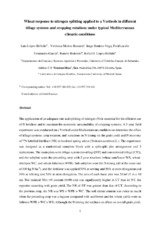Mostrar el registro sencillo del ítem
Wheat response to nitrogen splitting applied to a Vertisols in different tillage systems and cropping rotations under typical Mediterranean climatic conditions
| dc.contributor.author | López Bellido, Luis | |
| dc.contributor.author | Muñoz-Romero, Verónica | |
| dc.contributor.author | Benítez-Vega, Jorge | |
| dc.contributor.author | Fernández García, María Purificación | |
| dc.contributor.author | Redondo, Ramón | |
| dc.contributor.author | López-Bellido Garrido, Rafael J. | |
| dc.date.accessioned | 2024-01-11T11:01:35Z | |
| dc.date.available | 2024-01-11T11:01:35Z | |
| dc.date.issued | 2012 | |
| dc.identifier.issn | 1873-7331 | |
| dc.identifier.uri | http://hdl.handle.net/10396/26506 | |
| dc.description.abstract | The application of an adequate rate and splitting of nitrogen (N) is essential for the efficient use of N fertiliser and to maintain the economic sustainability of cropping systems. A 3-year field experiment was conducted on a Vertisol under Mediterranean conditions to determine the effect of tillage systems, crop rotation, and variations in N timing on the grain yield and N recovery of 15N-labelled fertiliser (NR) in hard red spring wheat (Triticum aestivum L.). The experiment was designed as a randomised complete block with a split–split plot arrangement and 3 replications. The main plots were tillage system (no-tillage [NT] and conventional tillage [CT]), and the subplots were the preceding crop with 2-year rotations (wheat–sunflower [WS], wheat–chickpea [WC], and wheat–faba bean [WFB]). Sub-subplots were the N timing (all at the same rate of 100 kg N ha−1), and the fertiliser was applied 50% at sowing and 50% at stem elongation and 50% at tillering and 50% at stem elongation. The area of each basic plot was 50 m2 (5 m × 10 m). The residual NO3–N content (0–90 cm) was significantly higher in CT than in NT, the opposite occurring with grain yield. The NR of NT was greater than that of CT. According to the previous crop, the NR was WS > WFB = WC. The soil nitrate content was twice as much when the preceding crop was a legume compared with sunflower and the wheat yields were as follows: WFB > WC > WS. Although the N timing did not have an effect on overall grain yield, the interactions with year, tillage system and previous crop were significant. The average recovery of 15N fertiliser by wheat was 44.6%, with 33.7% obtained in the grain (41% in stem elongation, 32% in tillering and 27% in sowing). The habitual use of high rates of N fertiliser and the frequency of dry years in the agrosystem studied generated a progressive accumulation of residual in the soil profile. This can represent an important source of mineral N for the cereal and can reduce the need to apply N fertiliser to the crop. | es_ES |
| dc.format.mimetype | application/pdf | es_ES |
| dc.language.iso | eng | es_ES |
| dc.publisher | Science Direct | es_ES |
| dc.rights | https://creativecommons.org/licenses/by-nc-nd/4.0/ | es_ES |
| dc.source | European Journal of Agronomy; Vol. 43, Pages 24-32 (2012) | es_ES |
| dc.subject | No tillage | es_ES |
| dc.subject | Soil nitrate | es_ES |
| dc.subject | 15N recovery | es_ES |
| dc.subject | Grain yield | es_ES |
| dc.subject | Sunflower | es_ES |
| dc.subject | Chickpea | es_ES |
| dc.subject | Faba bean | es_ES |
| dc.title | Wheat response to nitrogen splitting applied to a Vertisols in different tillage systems and cropping rotations under typical Mediterranean climatic conditions | es_ES |
| dc.type | info:eu-repo/semantics/article | es_ES |
| dc.relation.publisherversion | https://doi.org/10.1016/j.eja.2012.05.002 | es_ES |
| dc.relation.projectID | Unión Europea. AGL2003-03581 | es_ES |
| dc.relation.projectID | Unión Europea. AGL2006-02127/AGR | es_ES |
| dc.rights.accessRights | info:eu-repo/semantics/openAccess | es_ES |

